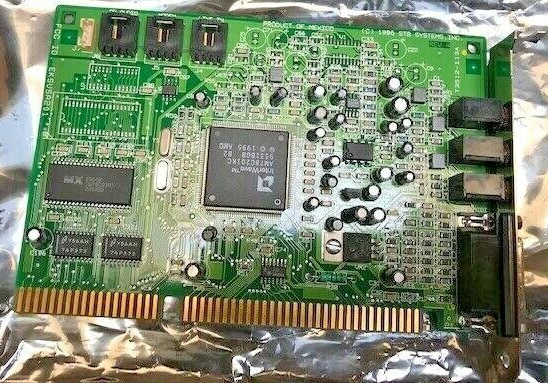STB was an early manufacturer of multi I/O, graphics and sound cards for the IBM PC and its compatibles.
STB Systems are mostly known for their graphics cards throughout the DOS era. In chronological order they are:
 Graphix Plus Graphix Plus
Launched: 1984
Bus: 8-bit ISA
Price: ?
The Graphix Plus card was a CGA-compatible graphics card that also supported high resolution monochrome graphics. Also common to many graphics cards in 1984, this one provided a parallel printer port too.
Advert
|
 Graphix Plus II Graphix Plus II
Launched: 1985
Bus: 8-bit ISA
Price: ?
Expanding on the earlier Graphix Plus, the II provides the same CGA features but adds a 16-colour mode. It also got a parallel port, a lightpen port, 32K of onboard video RAM, and an optional clock/calendar with battery backup.
Advert
|
EGA Plus
 Launched: 1986? advertised in 1987 Launched: 1986? advertised in 1987
Bus: 8-bit ISA
Chipset: Chips & Technologies CS8240
Price: $279 (Mar 1987)
An EGA-compatible card with Centronics printer port.
More Images
 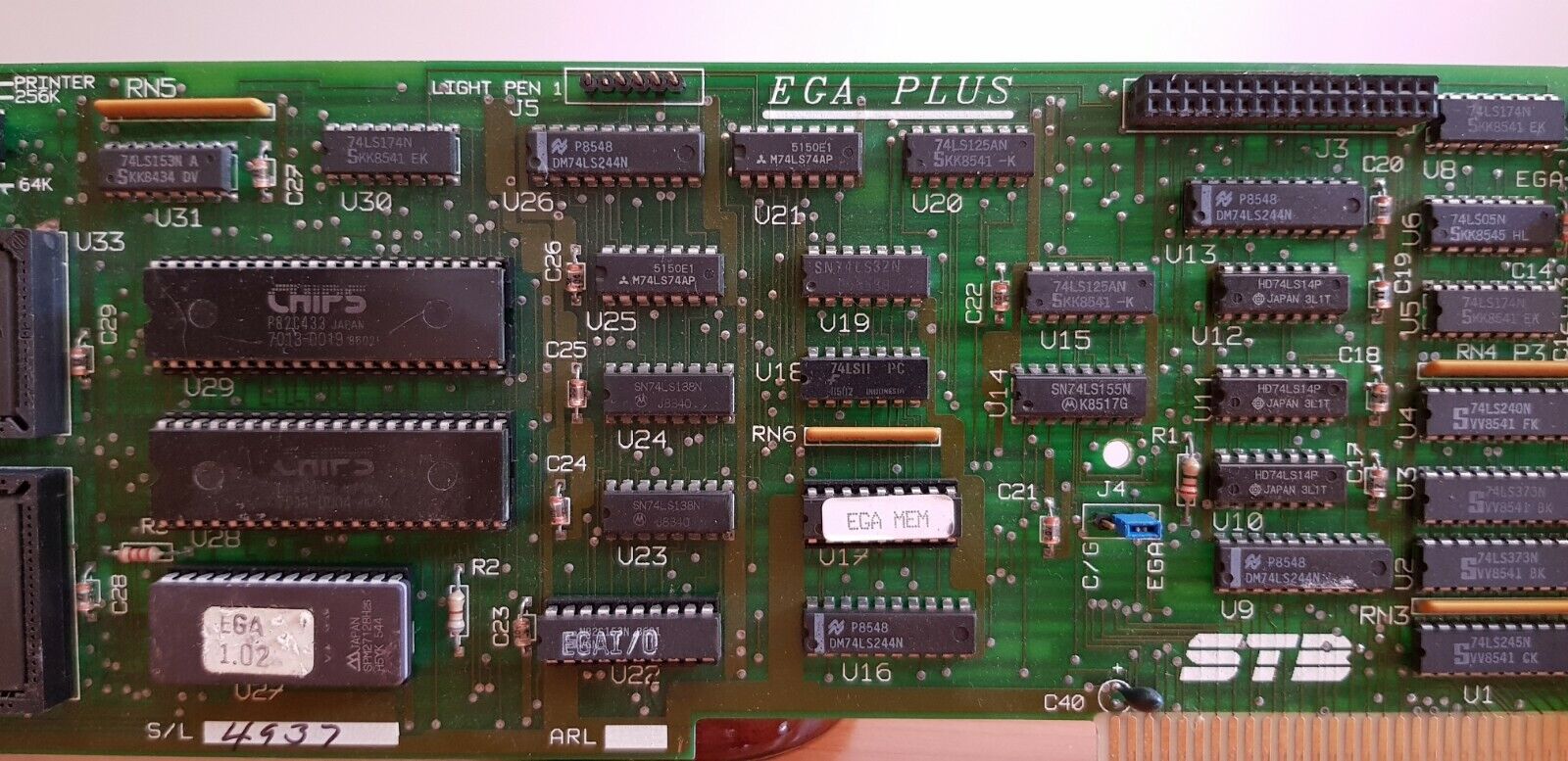  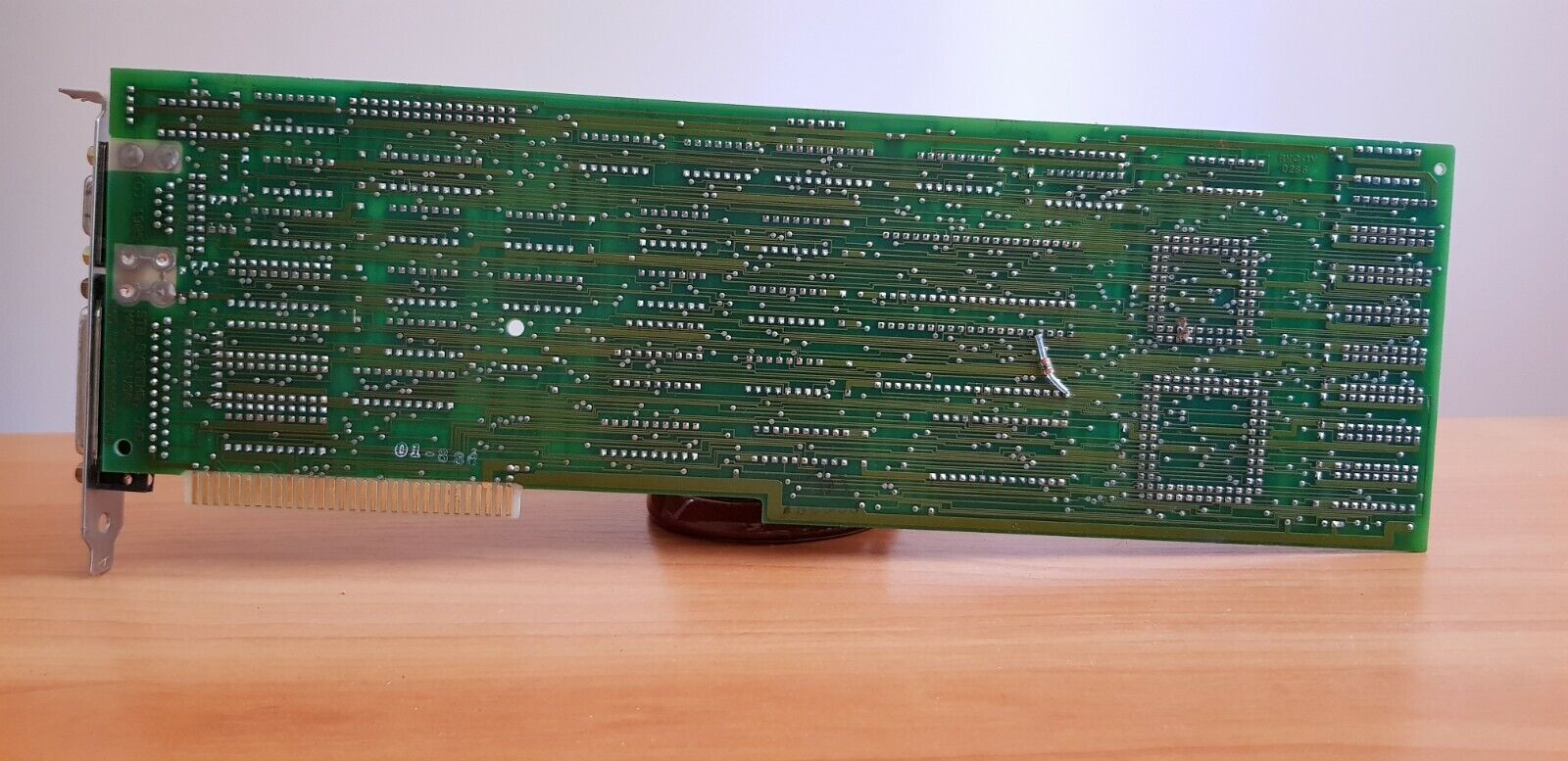 
|
 Chauffeur Chauffeur
Launched: 1987
Bus: 8-bit ISA
Price: $219 (Mar 1987)
(No info on this card) |
 Chauffeur HT Chauffeur HT
Launched: 1987
Bus: 8-bit ISA
Price: $239 (Mar 1987)
, $135 (Jan 1989)
The Chauffeur HT was a Hercules-compatible card that supported for the first time a resolution of 1056 x 352, ideal for a 132-character wide display in text modes. It came with drivers for Microsoft Windows, AutoCAD, Lotus 1-2-3 and Lotus Symphony.
Advert
Advert 2 |
 EGA Multi Res EGA Multi Res
Launched: 1987
Bus: 8-bit ISA
Price: $169 (Jan 1989)
The EGA Multi Res extended the IBM standard EGA by offering [on a multisync monitor] 640 x 480 and even 752 x 410 resolution in Microsoft Windows. On standard EGA monitors, it could display up to 832 x 350.
Advert |
.JPG) VGA Extra/EM VGA Extra/EM
Launched: 1987
Bus: 8-bit ISA
Chipset: Tseng Labs ET3000AF
Memory: 256 KB (upgradable to 512 KB)
Price: ?
The VGA Extra/EM was one of STB's first Super VGA cards, supporting resolutions of up to 1024 x 768 (interlaced) in 16 colours and 800 x 600 in 256 colours. Based on the Tseng Labs ET3000 chipset, it supported all the IBM VGA standard video modes including the extended text modes up to 132 columns by 44 rows.
Click here for the two ROM dumps (provided by Andrew Welburn): TROM v1.8, VGA EM v1.48
All pictures here were provided by Andrew Welburn of Andys Arcade.
More Images
.JPG) .JPG)  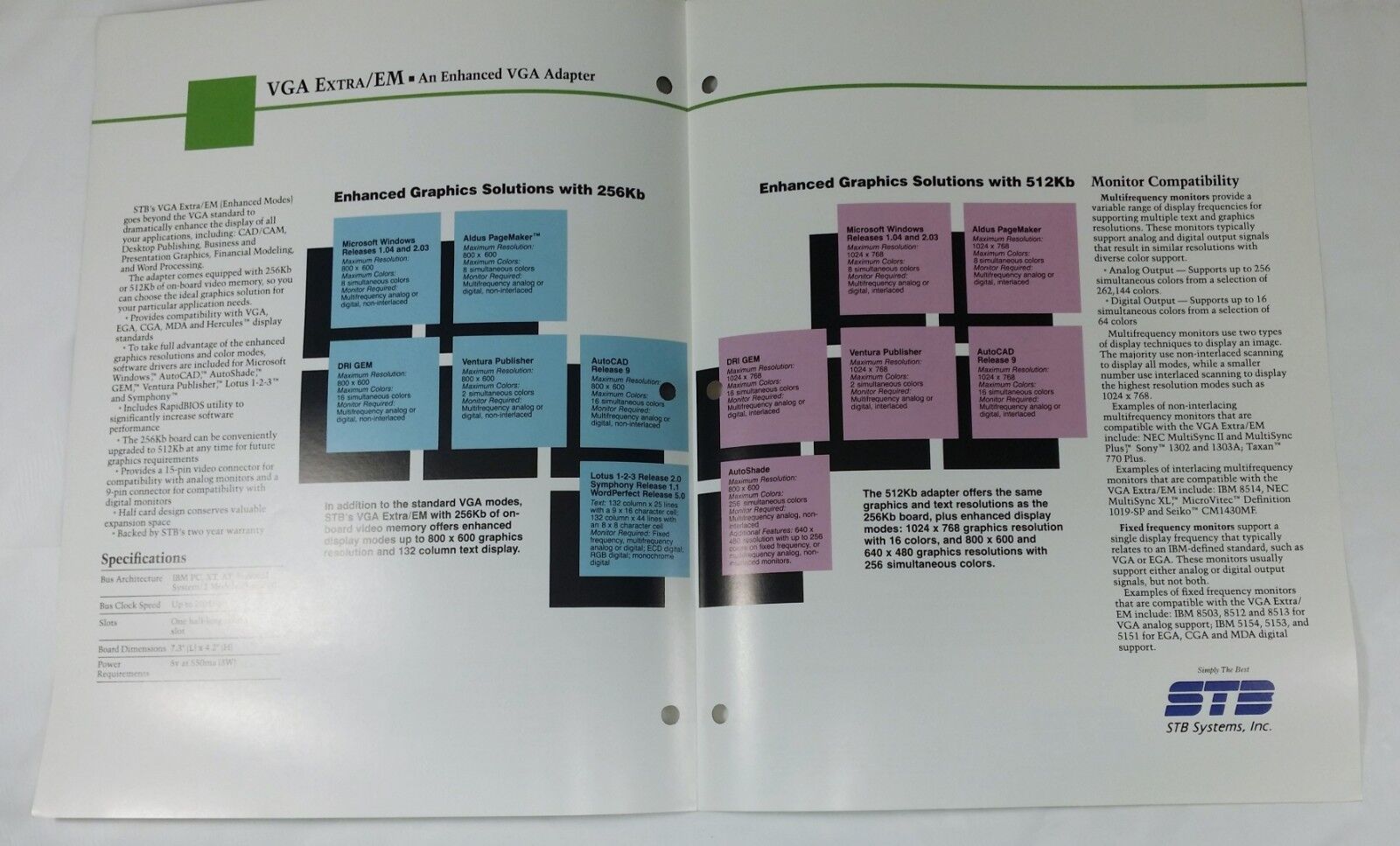 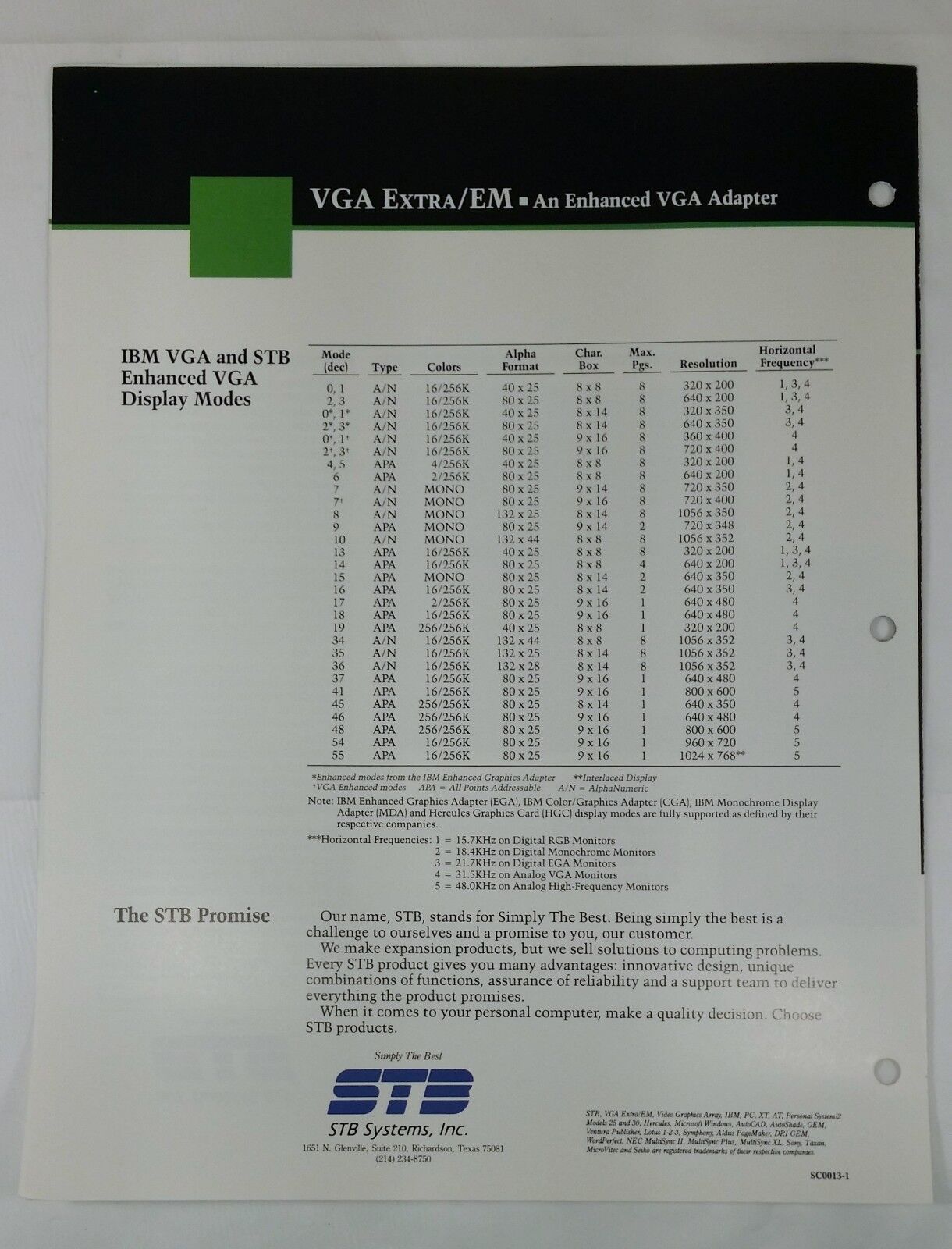
|
.jpg) MS+, MS Plus MS+, MS Plus
Launched: 1989
Bus: 16-bit ISA
Chipset: Tseng Labs ET3000AX
Memory: 256 KB (upgradable to 512 KB)
RAMDAC: BT476KP66
RAMDAC Speed: 66 MHz
Price: ?
Known Board Revisions: E
BIOS Versions:
1.09
The MS+ was a later Super VGA card based on the Tseng Labs ET3000 chipset. It came with 256 KB soldered-in, but could be upgraded to 512 KB via eight 64Kx4 DRAM chips.
All pictures here were provided by Andrew Welburn of Andys Arcade, as well as the BIOS ROMs: Odd, Even
More Images
.jpg) .jpg) .jpg)
|
Powergraph / Powergraph 2.0
 Launched: 1991? Launched: 1991?
Bus: 16-bit ISA
Memory: 512 KB
Chipset: Tseng Labs ET4000AX
Price: $201 (512 KB)
"STB PowerGraph Ergo-VGA
PROS: Low price, fast AutoCAD performance
CONS: Menuless driver installation
At a street price of $201 with 512K of RAM, STB's PowerGraph Ergo-VGA is
one of the three least expensive boards reviewed. It's an attractive buy, offering both fast performance and nearly switchless installation.
The PowerGraph tied for first place in the AutoCAD tests. CAD performance hounds should note that this board lists for $200 less than Orchid's equally speedy ProDesigner II.
As with the SigmaVGA Legend, you may have to move a jumper or two: one for 72-Hz screen refresh at 800 by 600, and the other to avoid conflicts with your network card. When you install drivers, there are no menus; you must do so from the command line.
If you use AutoCAD and you're looking for a fast VGA board at a bargain price, the PowerGraph is an excellent choice." PC World, August 1991
I have done some benchmark testing with this card in my OPTi 386/486 Hybrid motherboard review (page 2).
More Images
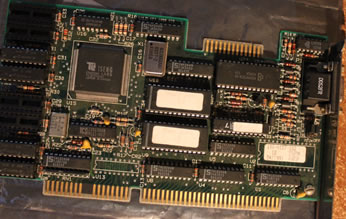
|
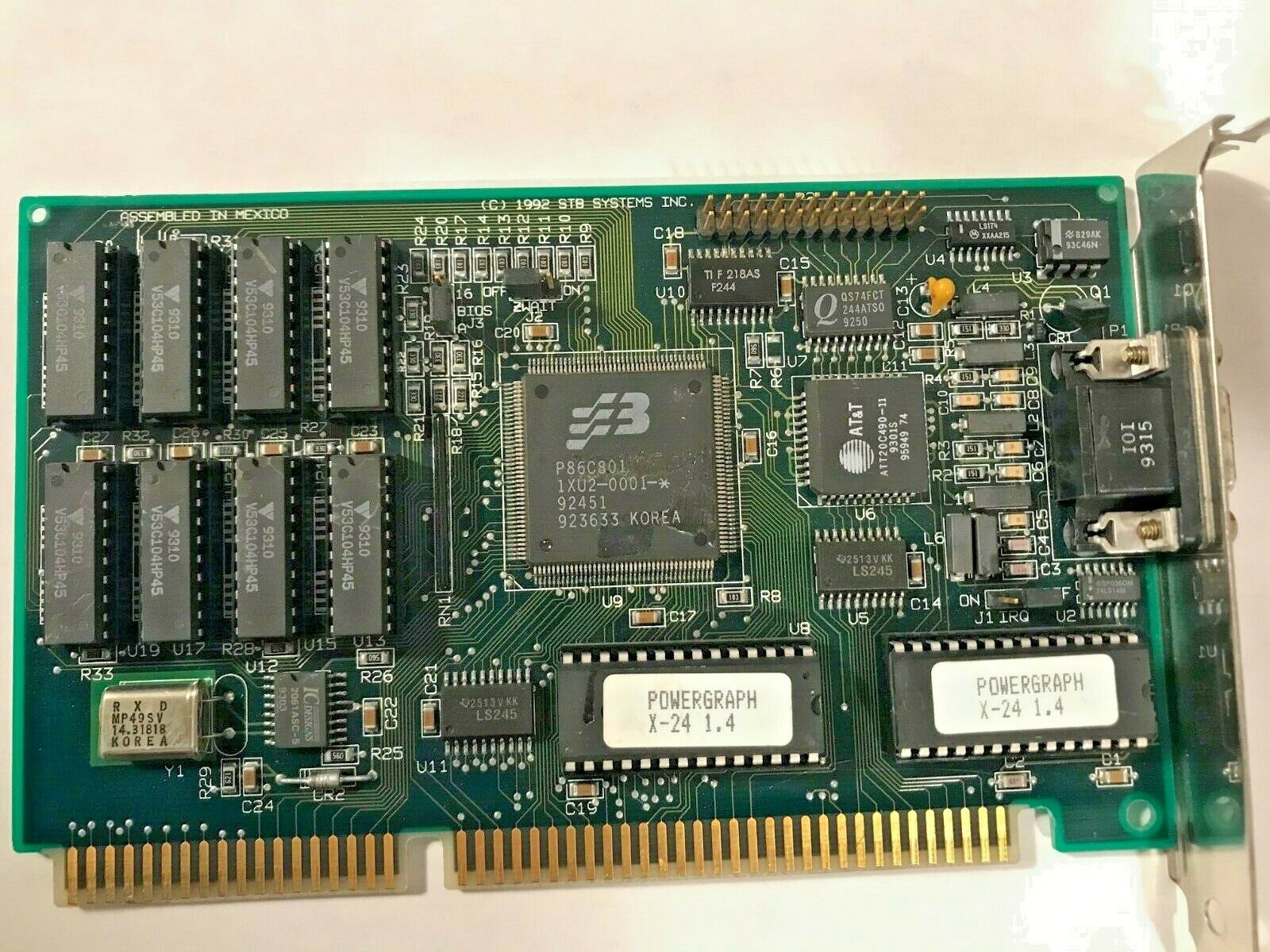 Powergraph X-24 Powergraph X-24
Launched: 1992
Bus: 16-bit ISA
Chipset: S3 86C801
Memory: 1 MB
FCC ID: EKSUSA801
Price: $
The Powergraph X-24 was a Super VGA card based around S3's 86C801 chipset.
More Images
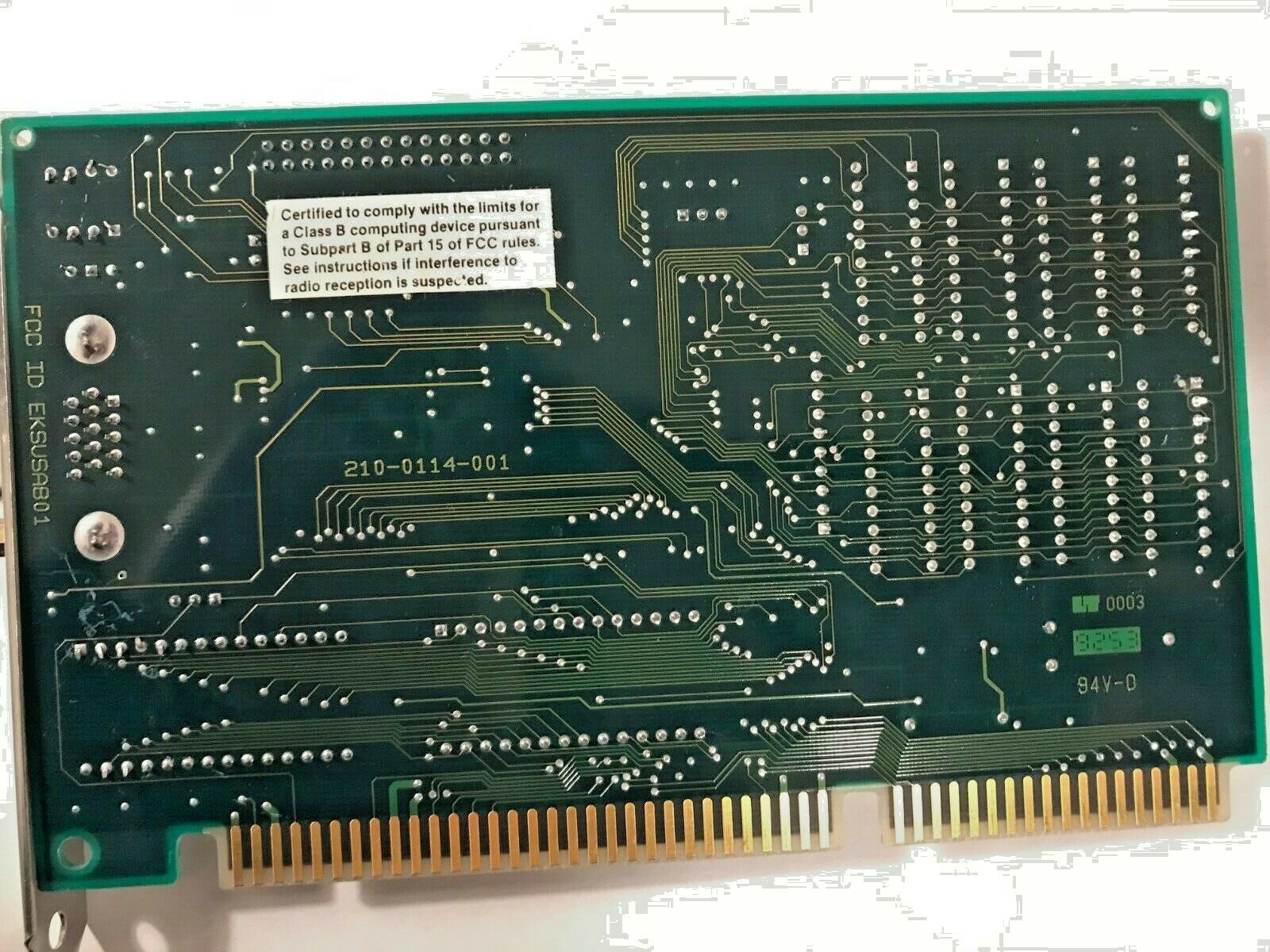 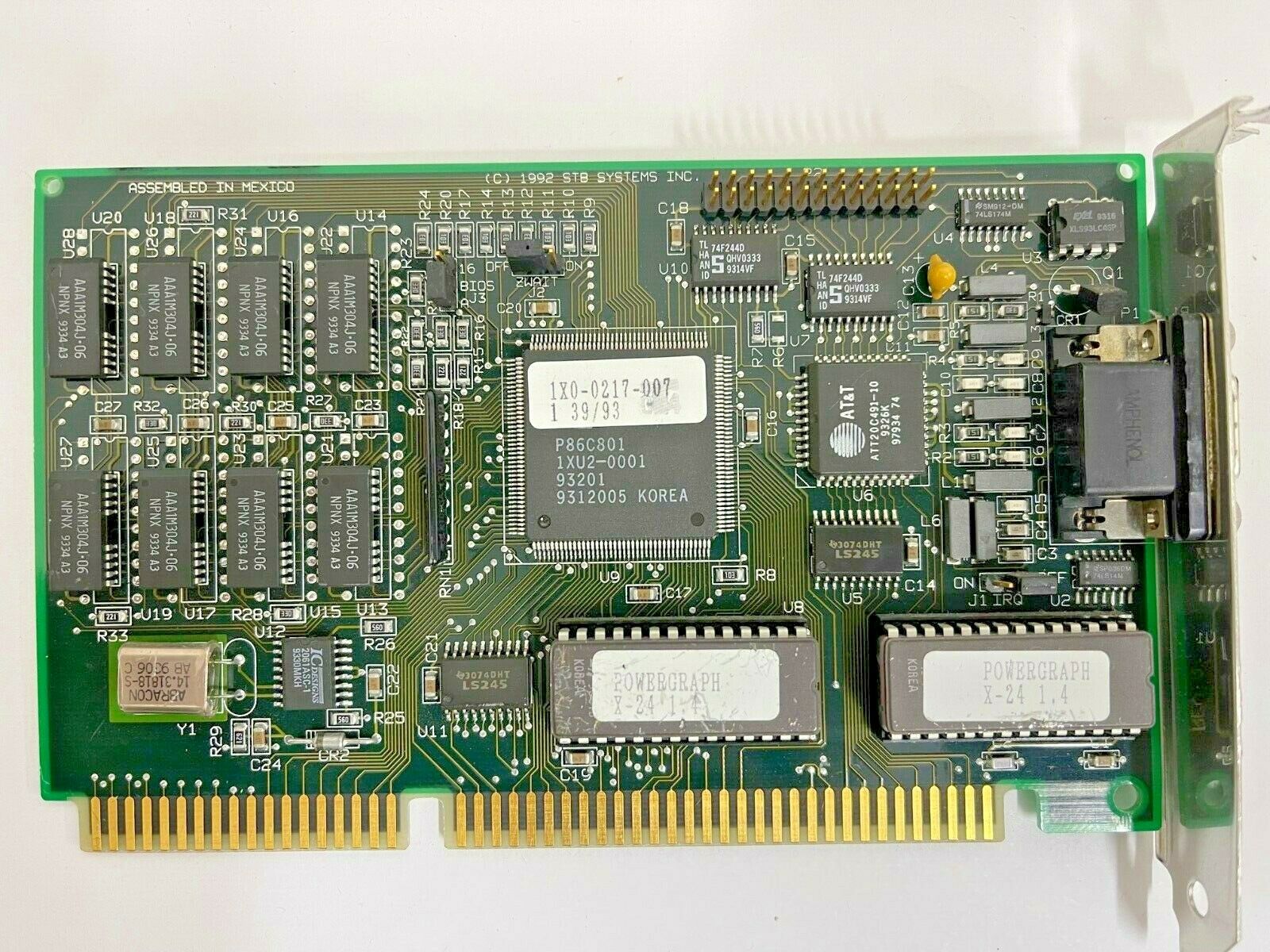 
|
 1280 Graphics System 1280 Graphics System
Launched: 1992
Bus: 16-bit ISA
Memory: 1 MB or 2 MB
Chipset: Chips & Technologies 480
Price: $426/$551 (1 MB/2 MB, Feb '92)
"STB's 1280 Graphics System is a very capable performer, featuring easy installation, flicker-free operation, and good color support at a reasonable cost. Its moderate $426 street price makes it a worthwhile competitor to many of the S3 boards.
Speed improvements were respectable, with Excel and Word for Windows running more than 2 1/2 times faster. PowerPoint graphics poked along at half their super-VGA clip, but that's better than with most S3 boards. The board provides 15 drivers, although only Windows and AutoCAD are accelerated; the other applications run at super-VGA speeds.
The 1280 Graphics System is one of two boards that display 256 colors at 1280 by 1024, if you invest $125 in the extra 1MB of RAM. Installation is both switchless and menu driven, making this a good value for Windows and AutoCAD users. "
PC World, March 1992
|
 WIND/X WIND/X
Launched: 1992
Bus: 16-bit ISA
Chipset: S3 86C911
Memory: 1 MB VRAM (80ns)
Price: $499 (Mar '92)
STB Systems' WIND/X ran on the S3 86C911 "Carrera" Windows accelerator chipset and came with 1 MB of VRAM. It directly competed with the Orchid Fahrenheit 1280, Genoa WindowsVGA, ATI Graphics Ultra / ATI Graphics Vantage, and Diamond Stealth VRAM.
It could support display resolutions as high as 1280 x 1024 in 16 colours or 800 x 600 in 262,144 colours. No Sierra HiColor DAC option was provided. VESA VBE compatibility was built into the drivers (not in the BIOS).
One good feature of the WIND/X was its provision of a bus mouse port
STB also offered a WIND/X Ultra, which I assume came with a HiColor DAC(?).
"The STB WIND/X test results put it on par with the generally lower-end-performing Genoa and Pixel accelerators. The Wind/X, however, performed significantly better than the Genoa and Pixel acceleratorson the Unscrolled Text BIOS Write test (the write test stressed by most vendors) but significantly worse on the Scrolled Text BIOS Write test. Additionally, on the 320-by-200 Fill and 320-by-200 Screen-to-Screen BitBlt tests, its performance ranged from 52 to 89 percent faster than the Genoa and the Pixel."
PC Magazine, March 1992
"STB's S3-powered WIND/X board is cheaper than the 1280 Graphics System. For just $355 (estimated street price) you get 65,536 screen colors at 640 by 480,11 software drivers, and a mouse. If you don't mind fidgeting with tiny jumpers, this is a very good product.
The WIND/X showed no speed surprises, chugging right along with the rest of the S3 boards. Expect 2 to 2.5 times the speed for Excel and Word for Windows and one-third the speed for PowerPoint graphics compared to super VGA.
STB's WIND/X provides flicker-free operation at all resolutions except its interlaced 1280 by 1024 mode. It's a good performer that's loaded with nice extras. Were it not for the myriad tiny jumpers, it would merit a Best Buy. But the WIND/X is still a very good deal."
PC World, March 1992
More Images

|
 Velocity 64V Velocity 64V
Launched: 1995
Chipset: S3 Vision968
Bus: PCI
Memory: 4 MB EDO VRAM
RAMDAC: IBM RGB524
RAMDAC Speed: 220 MHz
Price When New: $449
The Velocity 64V was based on S3's Vision968 chipset, just like numerous competitors this year including the Number Nine Motion 771, Diamond Stealth 64 Video VRAM, ELSA Winner 2000 Pro/X, Genoa VideoBlitz III AV, and Hercules Graphite Terminator Pro.
It supported resolutions up to 1600 x 1200 in 64,000 colours at 80 Hz.
"STB Systems' Velocity 64V is a more-than-able Windows performer, and with a list price of $449, it's hundreds of dollars less expensive than most cards in this roundup. It lacks some professional amenities, such as the ability to handle 24-bit images at its top resolution of 1,600 by 1,200 pixels, but it still offers a respectable platform for true-color graphics in resolutions up to 1,280 by 1,024 pixels. Professionals will probably want to consider a faster, more feature-packed card, but for high-end business applications supplemented by some color work, the Velocity is an attractive choice.
Outfitted with 4MB of EDO (extended data out) VRAM that gives it faster memory-to-controller performance, the Velocity is one of six cards we reviewed based on the popular S3 Vision 968 graphics accelerator chip. This 64-bit graphics engine features a full set of the standard Windows acceleration functions plus hardware acceleration for scaling digital video in Cinepak, Indeo, and Video for Windows formats.
The Velocity's refresh capabilities, provided by IBM's 220 MHz RGB524 RAMDAC, are thoroughly respectable if not quite stratospheric. It can manage an ergonomic 80-Hz refresh rate in 16-bit color mode at 1,600 by 1,200 pixels, and in true-color 1,280-by-1,024 mode it runs at 85 Hz. Lower resolutions with 24-bit color depths can be pushed to a nearly flicker-free vertical refresh rate of 100 Hz.
The STB card delivered respectable Windows acceleration as well. Although it performed slightly below average on our applications-based Winstone 95 tests, it achieved better results than some higher-priced cards, including the MGA Impression Plus cards. Running in 16-bit color mode at 1,600-by-1,200 pixels, it placed in the middle of the pack on our Graphics Winmark 95 tests. Boosting the color depth hurt performance, cutting the Velocity's rankings at 1,200-by-1,024 resolution to near the bottom of the heap.
In handling standard vector drawings, the card proved as adept as the leaders. Photoshop users will note, however, that it dropped to the middle of the lineup on our Raster Rotate test.
Unfortunately, AutoCAD drivers did not arrive in time for our tests; the company claims that they will be available by the time you read this.
In hands-on tests, we found STB's bundled software controls adequate to most tasks. The installation routine is fairly straightforward and offers a list of over 300 predefined monitor setups, so you don't need to spend time playing with refresh rates and resolutions. A group of icons lets you switch Windows resolutions on the fly.
In addition to the standard suite of bird's-eye zoom and DPMS controls, STB includes ColorIt with the Velocity. ColorIt lets you adjust RGB levels, brightness, contrast, and color temperature. It also contains a handy list of settings to adjust your display automatically to match the lighting conditions in your work space. Unfortunately, conducting precise gamma
correction with ColorIt is a tricky process: If you want a specific setup, you need to know exactly what numerical values to enter.
One other notable software feature is STB's multiple-desktop utility, which lets you hide applications on different virtual screens. You can
save, say, Program Manager on an 800-by-600, 256-color screen and Photoshop on a 1,280-by-1,024, 24-bit color screen. When you switch between desktops, the resolution and color depth change automatically. The only danger is forgetting where your application is.
To those looking for an inexpensive Windows hot rod that can double as a part-time 24-bit graphics vehicle, the Velocity 64V has several points in its favor. Those who want more should spend more money on one of the faster 24-bit color performers in this roundup."
PC Magazine, June 1995
|
 Horizon 64 / Horizon 64 Video Horizon 64 / Horizon 64 Video
Launched: 1995
Chipset: Alliance ProMotion 6422
Bus: PCI
Memory: 1 MB or 2 MB
Price: ?
The Horizon 64 Video was based on the Alliance ProMotion-6422 chip, which was a 64-bit integrated 2D Windows /VGA/motion video accelerator. It supported 1, 1.5 or 2 MB of EDO or FPM DRAM memory.
The core clock of the ProMotion-6422 ran at 135 MHz, and it supported a maximum resolution of 1280 x 1024. |
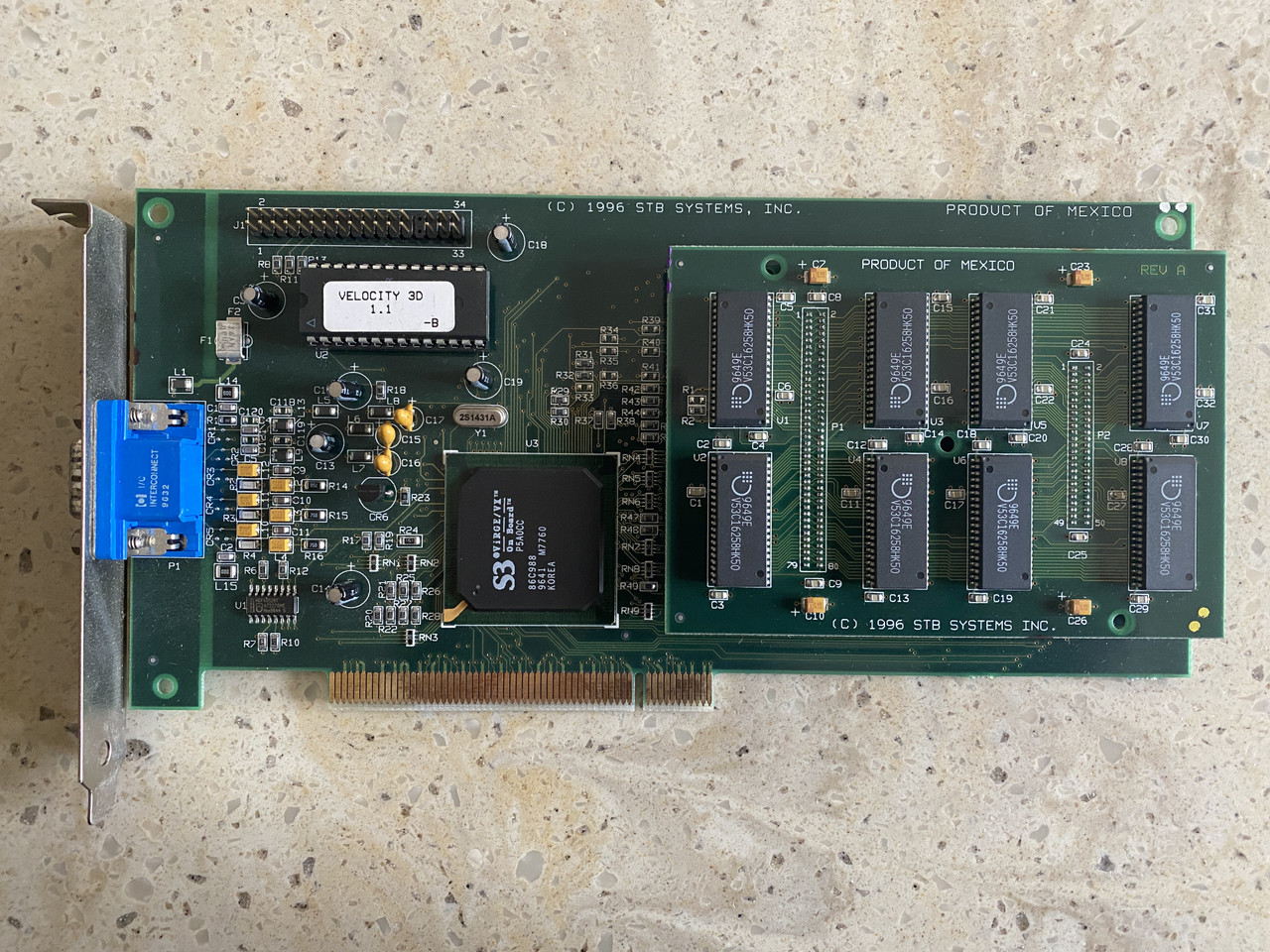 Velocity 3D Velocity 3D
Launched: 1996
Chipset: S3 ViRGE/VX
Bus: PCI
RAMDAC Speed: 220 MHz
Memory: 4 MB EDO VRAM (expandable to 8 MB)
Price: ?
The Velocity 3D was STB Systems' card based around the S3 ViRGE/VX chipset. The card in the pic above has the optional 4 MB DRAM memory upgrade installed.
Images shown for this card are courtesy of Vogons member, Artex.
More Images
   
|
 Lightspeed 128 Lightspeed 128
Launched: 1996
Bus: PCI
Memory: 2.25 MB
Chipset: Tseng Labs ET6000
Price: -
The STB Lightspeed 128 arrived in 1996 and was their first with a 128-bit graphics engine. From their website, STB said this:
STB Systems presents a new generation of graphics and video acceleration with the STB LIGHTSPEED 128 . The pure power of 128-Bit graphics acceleration is now yours at 64-Bit accelerator prices. By using a full 128-Bit graphics engine with advanced Multibank MDRAM technology, the LIGHTSPEED 128 delivers the maximum graphics horsepower with multiple accelerated video windows at full motion with as little as 2MB of memory. Get no-compromise graphics acceleration with enough bandwith to support full-motion video windows and Plug-and-Play support for Windows 95 games and applications that really fly! . The pure power of 128-Bit graphics acceleration is now yours at 64-Bit accelerator prices. By using a full 128-Bit graphics engine with advanced Multibank MDRAM technology, the LIGHTSPEED 128 delivers the maximum graphics horsepower with multiple accelerated video windows at full motion with as little as 2MB of memory. Get no-compromise graphics acceleration with enough bandwith to support full-motion video windows and Plug-and-Play support for Windows 95 games and applications that really fly!
- Maximum Performance 128-Bit Graphics/Video Accelerator
- 2.25MB of 720MB/second MoSys Multibank DRAM
- Supports Multiple Accelerated Video Windows in Resolutions to 1280x1024x256 Colors
- Integrated Digital Video Engine for Enhanced MPEG-1 and Microsoft DirectDraw Playback
- Flicker-free Refresh Rates up to 160Hz
OUTSTANDING DESIGN
- 2.25MB of Multibank MDRAM
- Tseng Labs ET6000 graphics controller chip
- Standard VESA-compatible feature connector
- PCI Bus model for high-performance video in PCI Bus compatible systems
- Fully supports VESA SuperVGA drivers (VBE 2.0)
- Hardware acceleration of Bit-Block transfers (BitBLTs), line drawing, cursor operation, dual address bus, read and write bursting, and hardware cursor
- High performance GUI drivers for Windows, Windows 95, Windows NT and OS/2 Warp
- Lifetime Warranty on retail products
WINNING PERFORMANCE
- 128-Bit graphics engine and Multibank DRAM interface for top GUI performance
- VESA DDC-2B support for Plug-and-Play monitors
- Supports non-interlaced resolutions up to 1280x1024 with 256 colors and 1024x768 with 65K colors
- STB VISION 95 utilities make Windows driver installation and screen configuration simple
- FCC Class B Certified for low emissions
REFRESH RATES (Hz)
Resolution/
Colors |
640 x 480 |
800 x 600 |
1024 x 768 |
1280 x 1024 |
| 256 |
60,72,75,85,
100,120,140,160 |
56,60,72,75,
85,100,120,140 |
88(i),60,70,75,
85,100,120 |
88(i),60,70,75 |
| 65K |
60,72,75,85,
100,120,140,160 |
56,60,72,75,
85,100,120,140 |
88(i),60,70,75,
85,100 |
-- |
| 16.7M |
60,72,75,85,
100,120,140,160 |
56,60,72,75,
85,100 |
-- |
-- |
"The Lightspeed 128 posted the highest PC WorldBench graphics score of any board we've tested. But to find out how much data it could really handle, we played multiple video clips simultaneously, and saw little degradation in video performance."
PC World, August 1996
More Images
|
 Velocity 128 / Velocity Riva 128 Velocity 128 / Velocity Riva 128
Launched: 1997
DAC: ?
Bus: AGP 1x/2x
Memory: 4 MB
Price: ?
Basically a rebadged nVidia Riva 128. This STB card was OEM'd by Dell.
|
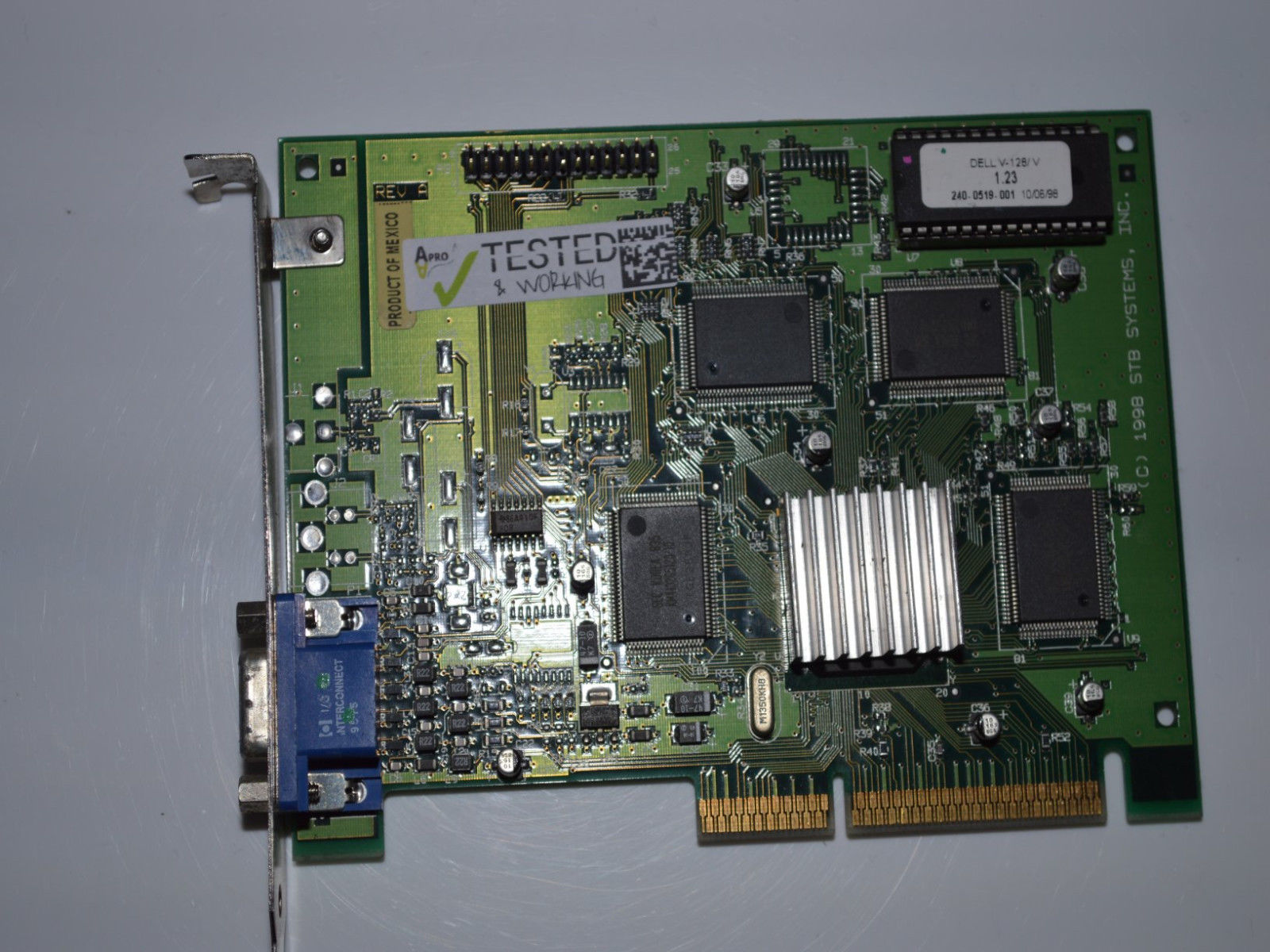 Velocity Riva 128ZX Velocity Riva 128ZX
Launched: 1998
DAC: ?
Bus: AGP 1x/2x
Memory: 8 MB
Price: ?
Basically a rebadged nVidia Riva 128ZX. This STB card was OEM'd by Dell. |
 Velocity 4400 Velocity 4400
Launched: Late 1998
Chipset: nVidia RiVA TNT
Bus: AGP 2x
Memory: 16 MB SDRAM
RAMDAC Speed: 250 MHz
Price: $199 (list price at launch)
STB were the first company to produce a card based on nVidia's RiVA TNT chipset, and this card was their last. It was bundled with Web3D, Forsaken, Colorific 3Deep, 3D Sensations, and Digital Video Producer.
It supports a maximum 2D resolution of 1920 x 1200 at a 76 Hz horizontal refresh rate and 24-bit colour depth. At 800 x 600, you could push the refresh rate up to 140 Hz, and at 1024 x 768, 100 Hz.
"An nVidia faithful, STB adds the 4400 to its line of Velocity videocards, a name befitting this fastest of fast videocards.
Following reference specs, the Velocity 4400 harbors 16 MB of nonupgradable 125 MHz SDRAM coupled with a 250 MHz RAMDAC.
Curiously, the Velocity 4400's refresh rates are lower than the Viper V550's rates. Unlike the Viper V550, the Velocity 4400 comes with separate S-Video and composite TV outputs powered by BrookTree's 869KRF
TV decoder chip, on top of the standard monitor connector.
STB's drivers let you control TV-centering keys, fine-tune Direct3D and OpenGL visual attributes such as
auto mip-mapping and filtering, and more.
Apart from a slightly slower Battlezone benchmark, every other test put the Velocity 4400 neck-and-neck
with the Viper V550, with fractions of a framerate separating the two. D3D at 1024x768 looks especially delectable. OGL gaming, on the other hand, we would keep at 800x600. At 1024x768, frame rates bogged down to the high 30s - dual-Voodoo2 does 60fps under the same conditions.
2D output remained sharp and eye soothing, as did gaming under the TV output. This iteration of the BrookTree decoding came out clearer. Still, the 60Hz nature of TV output begs for gameplay, not word processing.
Dig it - this card is one powerful piece of silicon that's ready to rip into any of your games."
Maximum PC, November 1998
The Velocity 4400 comes with a video-out port. The card does not overclock well compared to other TNT cards such as the Hercules Dynamite TNT. |
 STB Systems
STB Systems Velocity 128 / Velocity Riva 128
Velocity 128 / Velocity Riva 128 Velocity Riva 128ZX
Velocity Riva 128ZX Velocity 4400
Velocity 4400





.JPG)
.JPG)
.JPG)



.jpg)
.jpg)
.jpg)
.jpg)











 . The pure power of 128-Bit graphics acceleration is now yours at 64-Bit accelerator prices. By using a full 128-Bit graphics engine with advanced Multibank MDRAM technology, the LIGHTSPEED 128 delivers the maximum graphics horsepower with multiple accelerated video windows at full motion with as little as 2MB of memory. Get no-compromise graphics acceleration with enough bandwith to support full-motion video windows and Plug-and-Play support for Windows 95 games and applications that really fly!
. The pure power of 128-Bit graphics acceleration is now yours at 64-Bit accelerator prices. By using a full 128-Bit graphics engine with advanced Multibank MDRAM technology, the LIGHTSPEED 128 delivers the maximum graphics horsepower with multiple accelerated video windows at full motion with as little as 2MB of memory. Get no-compromise graphics acceleration with enough bandwith to support full-motion video windows and Plug-and-Play support for Windows 95 games and applications that really fly!